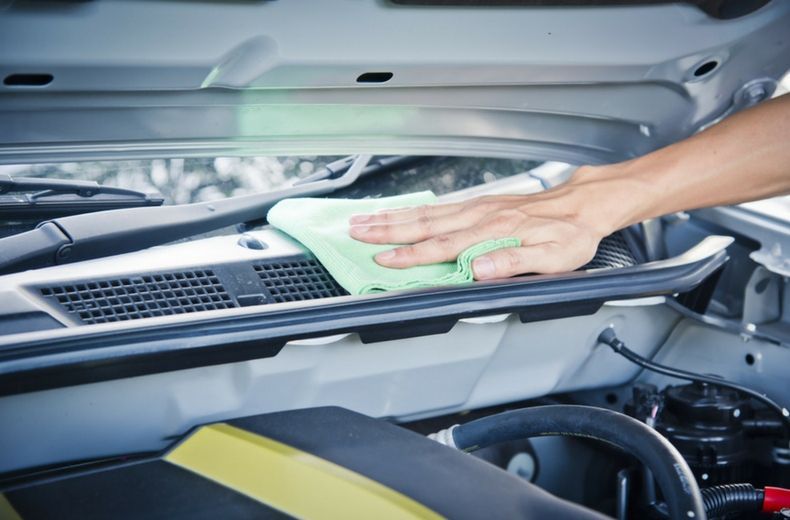Ways to make your car last longer
The RAC's top tips for prolonging your car’s life and keeping running costs down.
RAC have compiled 13 detailed, but easy-to-follow, tips to help you make your car more efficient, nicer to drive and last longer.
Many seem like straightforward common sense, but you’d be surprised how few drivers adhere to them all.
1. Change filters regularly
Your car’s oil filter and air filter become clogged over time, thus renewing them regularly is important.
They should be replaced as part of scheduled servicing, but both are relatively simple jobs – particularly an air filter swap – so you may wish to attempt them yourself. You could save money on servicing if so.
You can often prolong the life of the air filter by washing it, too.
Consult your handbook for advice on filter cleaning and changes, and be sure to use genuine parts. Cheap, poor quality filters could damage your engine in the longer term.
2. Drive smoothly… most of the time
Driving with mechanical sympathy is something you should practise regardless of whether the engine has warmed up.
Doing so will reduce wear and eke out more miles per tankful. Smooth inputs through the major controls – steering wheel, gearbox and pedals – are key, along with looking well ahead to reduce the need for sudden braking.
The RAC’s top fuel tips guide offers many more tips to improve your driving style to get the most out of your car and its fuel economy.
That said, if you never rev your engine fully, carbon deposits can build up and foul the valves, intake manifold and other parts, reducing efficiency and potentially causing a misfire.
You should, therefore, allow your engine to rev to the redline at least once every few hundred miles – but only when the oil is warm and you’re on a quiet road.
Diesel cars may also have problems with clogged diesel particulate filters (DPFs), which are designed to trap harmful exhaust emissions.
A longer motorway run once a month will help clear them.
3. Use your air conditioning
‘Use it or lose it’ is a phrase that could be applied to air conditioning.
Air-con systems inevitably leak refrigerant gas over time, particularly if they aren’t used regularly.
Leaving your air-con off may save fuel, but you could end up with a bill for re-gassing instead.
And yes, that means occasionally letting your vents blow cold in winter, too.
4. Replace spark plugs and leads
As cars become ever more complicated, drivers are – understandably – less inclined to do their own servicing.
However, replacing spark plugs and high-tension leads is another straightforward job you can do yourself to optimise your engine's performance, but you should always consult your vehicle handbook beforehand and stick to the service schedule.
When inspecting a spark plug check that it is has a light brown electrode and insulator, there are no signs of melting and no signs of wear or deposits.
A spark plug in a poor condition either indicates wear over time and needs replacing, or can hint at the condition of your engine.
If the plug is relatively new and has developed a significant gap between the electrode and the insulator then it could be an indicator that the engine is underperforming. If that's the case you should consult a reputable garage.
If the leads have cracks or show signs of heavy wear they should be replaced. We recommend using a reputable garage to carry this out, however, if you have the experience and feel confident enough then you should ensure you follow your vehicle handbook's guidelines.
Obviously this point doesn’t apply to diesel cars as they don’t use spark plugs.
5. Top up fluids regularly
Fluids are your car’s lifeblood, and failing to replenish them may have dire consequences.
Check your engine oil once a fortnight by opening the bonnet and removing the dipstick.
The oil level should be between the minimum and maximum markers – and a light yellowy-brown colour if your car has a petrol engine.
Dark, dirty oil should be replaced. Note, however, that diesel engine oil accumulates soot as part of the normal combustion process, so dark-coloured oil isn’t a cause for alarm with a diesel car.
Other areas to check fortnightly include the coolant reservoir – top up with 50% distilled water and 50% antifreeze – and the windscreen washer bottle.
We recommend a shop-bought screenwash for the latter.
Don’t be tempted to use washing-up liquid: it contains salt and other additives that will damage the paintwork.
6. Check your tyres
Tyres are arguably your car’s most important safety feature. Thus, it’s no exaggeration to say that checking them regularly – aim for once a week – could save your life. It could also save you money.
Under-inflated tyres will increase fuel consumption, so keep them topped up to the recommended pressures listed in your car’s handbook.
Remember, tyre pressures may be different for the front and rear tyres. Some car experts suggest rotating your tyres (i.e. swapping the fronts to the rear, and vice versa) in order to even out wear and prolong tyre life.
However, in the interests of safety, we recommend using the least-worn tyres on the back axle, as loss of front grip (understeer) is much is easier to manage than a rear-end slide (oversteer).
Having your car’s wheels professionally aligned may reduce tyre wear, too – with the added benefits of improved steering response and handling.
7. Stick to the service schedule
Regular servicing is vital to keep your car in tip-top condition and prolong its life.
Service intervals are based on time or kilometres driven – once a year or every 10,000 miles, for example.
Check the handbook to find out when your car is due to a service and what work is required.
Many modern cars have warning lights on the dashboard to alert you when maintenance is needed, too.
Broadly speaking, you should budget for a ‘minor’ service once a year and a ‘major’ service every two or three years.
A minor service includes changing the oil and oil filter and replacing other fluids if necessary.
Depending on the car and mileage, a major service may also cover replacement of the air filter, spark plugs and cambelt.
The number of tasks included in even a minor service is numerous, but all should include checks for oil and fluid leaks, tyre pressures and condition, excessive exhaust emissions, brake wear, and the correct operation of the steering, gearbox, clutch, suspension, lights, wipers and horn.
8. Keep your car clean
We all know people who never wash their car. Perhaps you’re one of them.
But keeping your car clean isn’t simply about the pride of ownership: it can significantly extend its life, too.
Grit and grime gets into moving parts and the chassis, leading to accelerated wear and corrosion.
Winter road salt is especially corrosive, while bird droppings play havoc with paintwork.
Take your car to a hand wash, or simply do it yourself. Automated car washes have stiff brushes that may leave fine scratches – plus they miss bits, too.
Use a proper cleaning solution rather than washing-up liquid and dry the car using a soft chamois.
Polish the paintwork at least once a year to provide a layer of protection and attend to stone chips promptly to prevent rust spreading.
It’s also important to keep the inside of your car clean.
Using a protective spray on the dashboard plastics reduces the likelihood of cracking or discolouration. Placing a sunshade in the windscreen on bright days helps here, too.
9. Keep it covered
Many of us have garages, but how many actually use them? OK, we’ll rephrase that: how many actually store cars in them?
As cars become larger and more corrosion-resistant, most are left on a driveway or road, with the garage effectively becoming an extension of the loft or garden shed.
Well, consider this your excuse for a clearout. Parking your car in a garage keeps it dry, clean and safe, reducing the risks of accidental damage, vandalism and theft.
It’s likely to cut your insurance premium, too. If you don’t have use of a garage, consider buying a high-quality car cover instead – particularly if you leave your car parked for long periods of time.
10. Keep the weight down
Carrying extra weight is a surefire way to dent your car’s fuel economy.
You’ll also put additional strain on wear-and-tear parts such as tyres, brakes and suspension bushes.
However, while it’s tempting to make the kids walk, a more practical solution is simply to remove any unnecessary objects from the car.
Start with the door pockets and glovebox, then look under the seats for any stray toys or drink bottles.
Moving on to the boot, clear out everything you don’t need. Just remember to leave the toolkit, jack and locking wheel nut key in case of emergencies.
11. Maintain your car’s battery
If you don’t use your car for long periods of time, the battery will degrade and go flat.
Jump-starting the car then puts additional strain on this essential component, and may damage the engine management system and other delicate electronics: a double-whammy of increased wear.
Consider using a trickle charger to keep the battery topped-up if your car is garaged.
If not, try to drive your car at least once a week – particularly in winter. Batteries don’t like cold weather too much!
12. Don’t scrimp on parts
Manufacturers cover millions of miles and spend billions on R&D to ensure their cars are as reliable as possible. So why put that in jeopardy with inferior-quality ‘pattern’ parts just to save a few pounds?
Using original parts could actually save you money in the long-run by keeping your car on the road.
And when it comes to classic cars in particular, originality is key to future value.
Giving your car the best also applies to the fluids you use.
Choose the engine oil recommended in the handbook and if you have a performance car that needs ‘premium’ fuel (e.g. super unleaded), use it.
That’s what the car has been designed and developed for.
13. Have your car rust-proofed
Modern cars are very rust-resistant, but metal corrosion is the number-one killer of vehicles built in the 1990s or before.
Once it sets in, many simply won’t be economical to repair.
If you see rust spots on your car, don’t wait for them to develop – at the very least, cover the exposed bodywork with touch-up paint before getting it professionally resprayed.
Applying a stone-deflecting film to the front of your car could prevent paintwork damage in the first place.
You could also have the chassis properly rust-proofed, which includes filling the cavities with a waxy substance designed to prevent water ingress.
Like all the tips here, it could save you money in the long-run.
14. Resist the temptation to modify
Modifying your car is likely to make it less reliable and shorten its life: fact.
Tuning the engine for more power puts extra strain on components, including the brakes if you drive faster as a result.
And stiffer, sportier suspension causes additional wear to the chassis, subframes and bushes.
Remember too, that money spent on modifications probably won’t increase the value of your car.
Indeed, the opposite is often true. Since depreciation is frequently the biggest cost involved in running a car, reducing the resale value shouldn’t be taken lightly.
Remember the above applies to pre-owned vehicles too! If you’re in the market and looking at cars for sale Cape Town or around - make sure you buy from a reputable dealership like Group 1 Cars to be sure you’re buying a quality used car for sale.
.
.
.
.
Article source:



Comments
Post a Comment